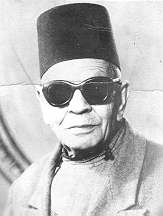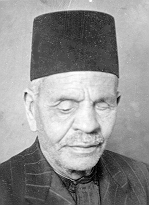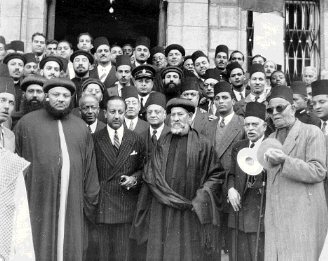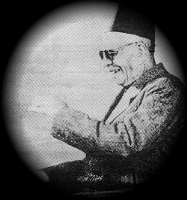The History of Recording Coptic Hymns in the 19th and 20th centuries.

By Ragheb Moftah Habashy
Published By El-Keraza
1975
Translated By Shenouda Mamdouh Jan. 6, 96
Introduction
Geniuses were among us and left for the other world. But their memories
live for ever as beautiful perfume. The artist "Newlandsmith" described
Moallem Mikhail by "Great Master" this title which is only given to international
artists. He is the source out of which is still flowing this great old
inheritance on the whole church since the last part of the 19th century
till after the middle of the 20th century..
This genius artist was born by a rich father who loved music and mastered
it and received part of it on the hands of the knowledgeable monk Botros
Moftah El-Antony who died on 1875.
Top
Moallem Takla
Moallem Mikhail was raised in a kind atmosphere.. Since his childhood his
sight was weak.. His father quickly realized the rich artistic gifts he
had and delivered him to the church to be taught the hymns.. He didn't
save any money to teach him.. So he was taught on the hands of Mlm.Morcos
and Mlm.Armanios who were students of Mlm.Takla (Fr.Takla later) who lived
in the time of HH Pope Kyrollos IV - father of reformation (Abul Eslah)..
In Mlm.Takla's times hymns were in their way to vanish and needed more
artistically originality and balance.. God helped Mlm.Takla to accomplish
this dangerous mission.. Pope Kyrollos IV assisted him with all the tools
and supplies.. He searched everywhere, from the North to the south and
from east to the west He collected hymns he found artistically tight and
right.. Until he collected in their best form all Coptic Tradition hymns
cited by Abul-Barakat Ibn-Kabar in his valuable Encyclopedia in 1320 ac.
Mlm.Takla was the instructor and teacher in the (Kottab - Small Class)
affiliated to the Patriarchate where rich people used to go until HH Pope
Kyrollos IV inaugurated the 'Coptic High School'.. My father (who was a
student there) used to say that Pope Kyrollos transferred them from this
Kottab to the High School and appointed Mlm.Takla, Hymn Instructor then
a priest for the Patriarchate then the Superior for the High School as
very knowledgeable in the church's rites..
Mlm.Takla issued with the co-operation of the French Musician "Gro"
a valuable book about music.. I searched so long for a copy and never found
any single trace.. He issued with Erian Efendy Gerges Moftah and for the
first time "The Deacon Service Book" Khedmet El-Shammas since 116 year!!
With the permission of Pope Kyrollos IV he added to the Coptic Hymns
treasure some ancient Greek Hymns such as "Ton Sina Narkhon Logon..", "To
Leesos.." and "Ee Parthenos..." it merged and found comfort with all Coptic
Hymns as happened in the past with the Greek Alphabet Set..
Mlm.Takla composed a Coptic Hymn in the profound spirit of Coptic Music
for Ismail Pasha Khedive of Egypt.. The Khedive was very impressed so that
he offered him the degree of Bek.. As Mlm.Mikhail told me and sang it to
me It took 12 minutes long !!I felt that Mlm.Takla was a Coptic Man, artist,
living in the first centuries of christianity !! He composed as well wonderful
Coptic songs that might be considered as folklore.. Many of Moftah's families
used to sing them at home..
I can't forget here to say that Pope Kyrollos asked Erian Bek MOFTAH
to fix the pronunciation of Coptic Language which was perishing over centuries..
He succeeded in that and that helped to sing Coptic Hymns in an easier
way..
God's blessing, 7 Cantors received all the treasure from Mlm.Takla and
mastered it perfectly.. It was really a reformation for the Church Art..
The Lord blessed it on the hands of Pope Kyrollos..
But this genius artist became crazy in the end of his days It seems
that was due to his overwhelming artistic feelings during his whole life..
Among these 7 some stayed in Cairo others went to other places such as
Tanta and Damanhour..
Top
Mlm.Mikhail Gerges El-Batanony
 Since an early
age Mlm.Mikhail considered seriously receiving the hymns with incomparable
love from two of the 7 Cantors: Mlm.Morcos and Mlm.Armanios.. Pope
Kyrollos V (HH mastered Hymns) realized that quickly, He gave him all HH's
attention and care and supervised by himself his teaching.. When
any Moallem was avaricious to teach him precious hymns.. The Pope used
to hide him under HH large seat in the Patriarchate, and ask this Mlm.
to let HH listen to the hymn.. And ask him to repeat it if needed.. Our
Mlm. Mikhail with his extraordinary memory could memorize it and master
it completely..
Since an early
age Mlm.Mikhail considered seriously receiving the hymns with incomparable
love from two of the 7 Cantors: Mlm.Morcos and Mlm.Armanios.. Pope
Kyrollos V (HH mastered Hymns) realized that quickly, He gave him all HH's
attention and care and supervised by himself his teaching.. When
any Moallem was avaricious to teach him precious hymns.. The Pope used
to hide him under HH large seat in the Patriarchate, and ask this Mlm.
to let HH listen to the hymn.. And ask him to repeat it if needed.. Our
Mlm. Mikhail with his extraordinary memory could memorize it and master
it completely..
As he reached his 19th of age he mastered the art of Church Music and
was appointed as Archpsaltos in the Patriarchate and first professor of
hymns in both the Theological Seminary and the Cantors's institute.. That
didn't bind him from increasing his treasure when any chance existed..
He brought a beautiful hymn from El-Menia "Apinav Shopi.." which wasn't
available in Cairo.. He didn't save any time to study and assure and compare
with other Moallems anywhere..
He was a loud "Baritone" which is the most suitable voice
for Church Music.. His rhythm and counting was also good, performing notes
clearly without any mistakes or deviation.. That's why although his voice
went hoarse when becoming old, he was still the most preferred one to perfection
seekers..
His ears and sub conscience were also very sensitive to music.. When
he was old, it happened for him to sleep profoundly while one of the students
was performing a hymn to him.. If the student made any mistake in melismata
he waked up.. He was really sleeping but his musical conscience never slept..
This phenomena was always happening. All of us saw it many many times..
And never it went wrong..
He was during his working life in the church (70 years), the master
of the word and situation in the whole Nile Valley.. directing all the
church hymns and annual even seasonal modes and rites... Nobody could
memorize what he did.. It was scarce when someone could know a close number
of hymns as he did.. Among whom, Mlm.Nassif Abdel-Messih who is still living..
Some of the first, others from the second generation, among his students
loved to be known of them that they received all what he had.. I
told 4 of them that I wanted to record the Gregorian Mass in their voices..
These 4 were Mlm.Farid Ibrahim, Mlm.Mikhail Salib, Mlm.Beshay, Mlm.Boules
Iskander (Mansoura).. They accepted.. and when seeing that I meant what
I said they said: "We want to assure our hymns with Mlm.Mikhail" That 'assuration'
was in fact receiving the Mass from it's very beginning!!
After that, each of them took one only part to master.. That took about
2 months of work and concentration in Alexandria until I was able to record
it from them.. With them was Rev.Hegomenos Morcos Gerges (Matay) who recorded
the "Reconciliation" and student from the Theological Seminary in Mahmasha..
All of them are now priests and deacons.. This study began in Alexandria
and remained, ten years before the inauguration of the Coptic Studies Institute..
It had high productivity.. That was because they were consecrated to study
all day long with a knowledgeable Cantor who was never bored.. Students
had hunger to receive from him and also loved to pass the Summer in Alexandria..
Among those who attended these studies people which I mentioned previously,
Mlm.Tawfik Youssef Cantor of El-Moharak Monastery, Mlm.Sadek Attalla, Dr.Youssef
Mansour and other deacons from Cairo and all Egypt's churches...
I opened a center in Old-Cairo, another close to Babelhadid Square in
Cairo for old cantors to assure and receive.. Mlm.Mikhail really
made a huge effort with patience and love.. Everyone who attended these
classes was remunerated at 25 Pt. Allowance of transportation.. That work
returned with a big profit on assuring and spreading hymns in Liturgical
services and Specialized institutes..
I send Mlm.Mikhail to El-Moharak Monastery 2 times without it's request..
He left there a big influence and profit which I can still feel ...
Top
Moalem Mikhail II
One of the Characteristics of Mlm.Mikhail was that he never forgot any
of the hymns.. During the 40 years he worked with me until his last days..
I never saw he forgot one hymn.. In few time counted on one hands' fingers
he revised himself in some few melismata in one hymn or another and get
sure of it..
He was able to recite any hymn begining from any verse or place without
the slightest hesitation.. Sometimes he knew two tunes for the same hymn..
Among which: the Joyful Agios, the big Tishory. We did in vain record both
tunes as we did record all hymns from him.. Also we recorded the big "Tee
oy en hikanos.." which takes 50 minutes!! No one now knows it except Mlm.Nassif
Abdel-Messih and Mlm.Tawfik Youssef (Moharek Monastery).. So none
of the hymns perished..
Mlm.Mikhail assured me that the Kyrollos Mass music perished long time
ago.. Nothing is available except "Ouoh Nay.." and Not we O Lord
"Oukoty je anon.." the response for the Commemoration of the Saints in
St.Kyrollos Mass which is sung in Lahn-Ayoub, the tune of sorrow..
Mlm.Mikhail composed some music for some parts of the Kyrollos mass..
Among people who received these hymns he composed was Fr.Athanasios Boutros
before leaving for St.Mina Church - Fleming, Alexandria.. Some of them
claimed that it is the right tune for this mass..
Concerning the tune which HH Pope Makarios III used.. we found a document
in his hand writing, which he wrote since he was Metropolitan for the Diocese
of Assuit.. where he wrote that it is his' and suitable..
I didn't record any of the previous two unless one claims in the future
that they are the original tunes for this mass..
Here is a secret I am telling for the first time: the monk Fr.Abdel-Messih
El-Massoudy the young wrote a paper in his own hand writing and signature
were he says that Mlm.Mikhail entered some prolongements to the responses
of the Mass and to some Awashies which were not there since the begining
of the 20th century
After the study of this issue I found that all the responses "maradat"
of the mass are original, balanced and beautiful.. No pronlongements were
made except in very few of them such as "Ke to Pnevmati so.." which is
better when shortened.. also "Keryeleison" which comes on it's same tune..
Knowing that some responses "maradat" have equivalent Big tunes usually
used in the "Sayedeya" feasts.. like nativity and resurrection..
Some parts of the mass which are common between the 3 masses (As the
commemoration of the Saints) appear to have the same music in the Gregorian
Mass as in the Basilian Mass BUT in grand and prolonged in some parts because
it is a ceremonial mass for Nativity, Baptism and Resurrection feasts..
It seems that Hegomenos Abdel-Messih El-Massoudy who scientifically
revised the 3 masses, commented them and added foot notes was probably
influenced by the "Zeeneya Bahary" style (Near Luxor) which merges the
church music with "Speaking" or reading during the mass or what was called
in monasteries to a very close area "The Mass in secret" which targets
to shorten the time taken by the mass.. Among it's characteristics that
is not clear and unlogic..
I think that the perfection of the church's traditions by both the priest
and the deacons is a very important tool to recite them in joy and life..
It won't take more than 90 minutes from the offering of the incense until
the end.. Adding to that 12 minutes for the speech.. which should be with
the Mass' Prayers, the readings and hymns short and concentrated...
I began my work with Mlm.Mikhail in Winter 1928 as I had already brought
the International Musician Prof. Newlandsmith to transcribe both the hymns
and the masses of the Coptic Orthodox Church.. People were claiming
by this time that Mlm.Mikhail is changing the hymns so I felt afraid to
bring him.. I collected names of all cantors in Egypt and asked all of
them to come from Cairo and all over Egypt.. Prof. Newlandsmith listened
to them all and then told me: "I want to apologize and cancel our deal
because I can't do this job accurately.. These cantors' voices are not
clear and pure and include a lot of deviations.."
So I brought Mlm.Mikhail who saved the situation at the moment!! I still
remember this decisive separative instant in recording the Church Hymns
as if it was just now!!.. We were on a Golden ship in the Nile in front
of El-Dobara Castle.. Under us, the Nile flew silently surrounded by wonderful
gardens by both beaches.. Mlm.Mikhail came.. Two great artists met!!
I asked him to recite a Coptic hymn to the professor.. An example showing
beauty and value of the Church Music.. He performed the hymn:
"Vi et ou enmashg..." -
"If you have ears, then, listen to what the Spirit says to the churches"..
On the tune of Hymn of Vertus and other hymns...
In this same moment Prof. Newlandsmith said: "I understood what he said
clearly. Now I can do my job accurately" and went on doing this job daily
(Except in the Summer) for nine years in a silent corner.. But active as
a bees cell..
Mlm.Mikhail realized profoundly the importance of this work to the whole
Music Inheritance.. He did his best from his profound feelings and heart..
He preferred it to all his duties and responsibilities (Which were many..)
In winter 1930 we should move because the ship had to be restored..
We were forced to take our things and move to the village where my father
had just built the new Villa.. We stayed there working in complete isolation
for three months.. Mlm.Mikhail left everything: his home and several duties
in the church, Theological Seminary and Societies..
He was so active that Prof. Newlandsmith felt he was making big pressure
on him to work and objected saying: "The artist should be left to work
without pressure That doesn't provide him the suitable atmosphere for work.."..
I will never forget Mlm.Mikhail at the end of each working season (before
summer) asking and begging Prof. Newlandsmith to transcribe one more hymn
just one more.. The prof. was replying: "I am preparing myself for
traveling" but the Mlm. was keeping on asking in all sincerity and children's
curiosity.. That is an evidence of what I stated previously (from his words)
concerning St. Kyrollos Mass.
Interesting situations happened, I brought one day Mlm.Salama from El-Mahala
El-Kobra (He was old and couldn't come before) He was an old man wearing
a black beret similar to the priests'.. So when Mlm.Mikhail arrived, Mlm.Salama
remained calm and silent in his room so that nobody could feel him.. But
the priority was always for Mlm.Mikhail.. A long time after Mlm.Salama's
departure I told Mlm.Mikhail.. He laughed so much.. and felt happy for
this benefit and accuracy we wanted..
Top
Moalem Mikhail III
 One day we were wandering
in the fields some sheep and cattle were far there standing immobile..
He asked me to stop pointed them with his finger and said: There is sheep..
I asked him how did you know although they didn't produce any sound or
movement.. Really he was full with feelings and sensitivity.
One day we were wandering
in the fields some sheep and cattle were far there standing immobile..
He asked me to stop pointed them with his finger and said: There is sheep..
I asked him how did you know although they didn't produce any sound or
movement.. Really he was full with feelings and sensitivity.
One day, HH Pope Youannes XIV visited us for he liked this job very
much.. He told us his great joy about it.. We went to visit HH and
have His blessing HH was praising Mlm.Mikhail so much. So Prof. Newlandsmith
told HH that it's not enough he should get a respectable retirement insurance
and be appointed only for the important work and to get a personal car
for transportation..
This work lasted until 1936, all hymns were transcribed, as well as
both St. Kyrollos and St. Basil's Masses in 15 Volumes.
The great musician Hans Hickman who spent all his life searching for
Ancient Egyptian's Music and the best who have written about it asked me
to help him studying Coptic Music, I gave him some of these volumes..
I visited him frequently accompanied by Mlm.Mikhail and he visited the
Patriarchate also.. It was proofed that hand signs made by Mlm.Mikhail
when reciting hymns are the same done by Ancient Egyptian singers and musicians
while singing.. Mr.Hickman is one of the people who support the point of
view that Coptic music has it's old sources in Ancient Egyptian art..
The third characteristic of Mlm.Mikhail during his 70 working years
is that he was working all day long since it's begining until he did finish
his work at 10:00 pm night of April 18th, 1957 and died at 12:00 pm of
the same night.. He was specialist in Coptic language, knowledgeable
in the church's seasonal rites and very skilled in Arabic Language rules..
He was kind inside his heart sincere in his soul and humble having all
the advantages and characteristics of artists or scientists.. He was living
in Fagalla in a street that showed the vaste "Jesuites School" calm gardens..
His first wife was a great woman very Coptic in her style..
 He kept
visiting me during his last 3 months saying "I am leaving" - "Ana Mashy"
so I was joking with him saying: "No wait! wait! we still need you" he
replied: "I love you so much.. you are the one who preserved the Church
music art" I told from my most profound feelings:" But the honor, all the
honor is to YOU"
He kept
visiting me during his last 3 months saying "I am leaving" - "Ana Mashy"
so I was joking with him saying: "No wait! wait! we still need you" he
replied: "I love you so much.. you are the one who preserved the Church
music art" I told from my most profound feelings:" But the honor, all the
honor is to YOU"
Top
Dear Copts that was the part written by Mr.Ragheb Moftah in 1975 about
Coptic Music recording and the wonderful job he did and all Mlm.Takla and
Mlm.Mikhail Gerges El-Batanony in the 19th and 20th centuries.
I tried to translate it.. As my native language is Arabic and first
Language is French, sorry for the poor English which was unable to transfer
all the included feelings.. But it provides VERY important
information about Coptic Music in Modern Ages..
That was all..
Translator
Shenouda Mamdouh
Top http://Come.to/CopticHymns
 He kept
visiting me during his last 3 months saying "I am leaving" - "Ana Mashy"
so I was joking with him saying: "No wait! wait! we still need you" he
replied: "I love you so much.. you are the one who preserved the Church
music art" I told from my most profound feelings:" But the honor, all the
honor is to YOU"
He kept
visiting me during his last 3 months saying "I am leaving" - "Ana Mashy"
so I was joking with him saying: "No wait! wait! we still need you" he
replied: "I love you so much.. you are the one who preserved the Church
music art" I told from my most profound feelings:" But the honor, all the
honor is to YOU"

 Since an early
age Mlm.Mikhail considered seriously receiving the hymns with incomparable
love from two of the 7 Cantors: Mlm.Morcos and Mlm.Armanios.. Pope
Kyrollos V (HH mastered Hymns) realized that quickly, He gave him all HH's
attention and care and supervised by himself his teaching.. When
any Moallem was avaricious to teach him precious hymns.. The Pope used
to hide him under HH large seat in the Patriarchate, and ask this Mlm.
to let HH listen to the hymn.. And ask him to repeat it if needed.. Our
Mlm. Mikhail with his extraordinary memory could memorize it and master
it completely..
Since an early
age Mlm.Mikhail considered seriously receiving the hymns with incomparable
love from two of the 7 Cantors: Mlm.Morcos and Mlm.Armanios.. Pope
Kyrollos V (HH mastered Hymns) realized that quickly, He gave him all HH's
attention and care and supervised by himself his teaching.. When
any Moallem was avaricious to teach him precious hymns.. The Pope used
to hide him under HH large seat in the Patriarchate, and ask this Mlm.
to let HH listen to the hymn.. And ask him to repeat it if needed.. Our
Mlm. Mikhail with his extraordinary memory could memorize it and master
it completely..
 One day we were wandering
in the fields some sheep and cattle were far there standing immobile..
He asked me to stop pointed them with his finger and said: There is sheep..
I asked him how did you know although they didn't produce any sound or
movement.. Really he was full with feelings and sensitivity.
One day we were wandering
in the fields some sheep and cattle were far there standing immobile..
He asked me to stop pointed them with his finger and said: There is sheep..
I asked him how did you know although they didn't produce any sound or
movement.. Really he was full with feelings and sensitivity.